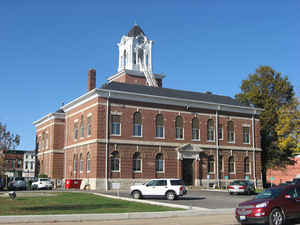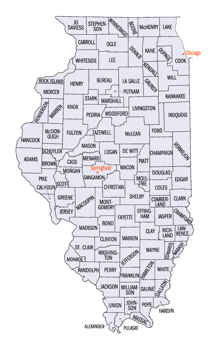Illinois Counties
There are one hundred and two counties in Illinois. St. Clair County was the first county established in what is today Illinois. Most counties in Illinois were named after early American leaders, especially of the American Revolutionary War, as well as soldiers from the Battle of Tippecanoe and the War of 1812.Clark County, Illinois
Clark County Education, Geography, and History
Clark County is a county located in the southeastern part of the state of Illinois, along the Indiana state line. Based on the 2010 census, the population was 16,335. Clark County was created on March 23, 1819. The county seat is Marshall. The county is named for George Rogers Clark, an officer who served in the American Revolution.
Etymology - Origin of Clark County Name
The county is named George Rogers Clark, soldier of the American Revolution and captor of Fort Vincennes and Kaskaskia.
Demographics:
County QuickFacts: CensusBureau Quick Facts
Clark County History
Clark County was created on March 23, 1819 (Laws, 1819, p. 166) and was formed from Crawford County. Present
area, or parts of it, formerly included in: Crawford County (1816-1819), Edwards County (1815-1816), Madison County
(1812-1815), St. Clair County (1809-1812), Randolph County (1809-1812) and Knox, Northwest Territory (1790-1809).
The County was named for George Rogers Clark, a soldier of the Revolution, who, as a Colonel of the Virginia
militia, established Colonial control in the Illinois country, by the capture of Kaskaskia and Fort Vincennes.
The County Seat is Marshall. Prior County Seats was Aurora (1818-1823), Darwin- Name changed from McClure's Bluff
(1823-1838) and Marshall (1838-Present).
Clark County is located in Southeastern Illinois. It was originally part of the Northwest territory. The first pioneer settlement was York, on the Wabash (Ouabache) River, before 1816. The present county was formed out of Crawford County in 1819, just a short time after Illinois became a state. At that time, the northern border of Clark County ran all the way to what would become Wisconsin. The County was named for George Rogers Clark, whose fame came mainly from his exploits on the Illinois frontier during the Revolutionary War. The first settlers came from Virginia, Ohio and Kentucky. Many were veteran soldiers of the War of 1812. Settlement increased after the construction of the National Road through the county. Clark County's first County Seat was at Aurora, on the Wabash River. The County Seat was moved to Darwin in 1823 when the good citizens of Aurora realized that the River could flood higher than they could build. In 1839, a county-wide election was held to decide on a new County Seat. The contenders were Marshall, and Auburn. The tempers were high as the voting day drew near and the tension grew. In spite of Auburn changing it's name to Clark Center, Marshall won the day and has been the County Seat of Clark County ever since.
Geography: Land and Water
As reported by the Census Bureau, the county has a total area of 505 square miles (1,308 km2), of which 502 square miles (1,299 km2) is land and 3 square miles (9 km2) (0.67%) is water.
Clark county is located in southeast Illinois. Part of the county's eastern border is
defined by the Wabash River. Lincoln Trail State Park is located in this
county.
Neighboring Counties
Bordering counties are as follows:
- North: Edgar County
- Northeast: Vigo County, Ind.
- Southeast: Sullivan County, Ind.
- South: Crawford County
- Southwest: Jasper County
- West: Cumberland County
- Northwest: Coles County
Education
There are three school districts in Clark County (Marshall, Martinsville and Casey-Westfield) with a total enrollment (2004) of 3,014 students. Each district has one high school (grades 9-12) and one junior high school (grades 7-8). Marshall has two elementary schools and the other districts have one each.







